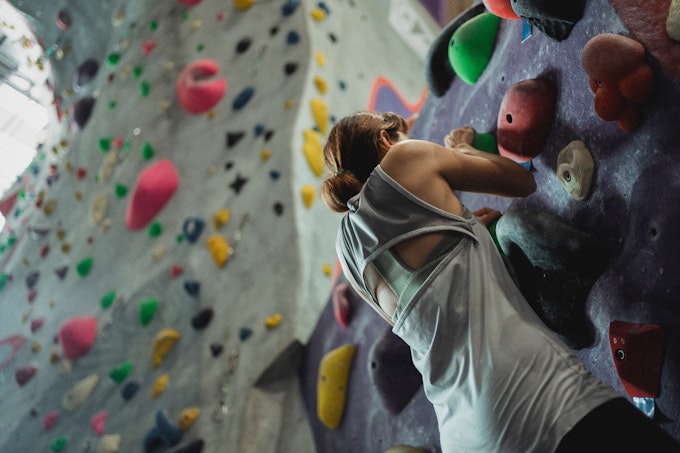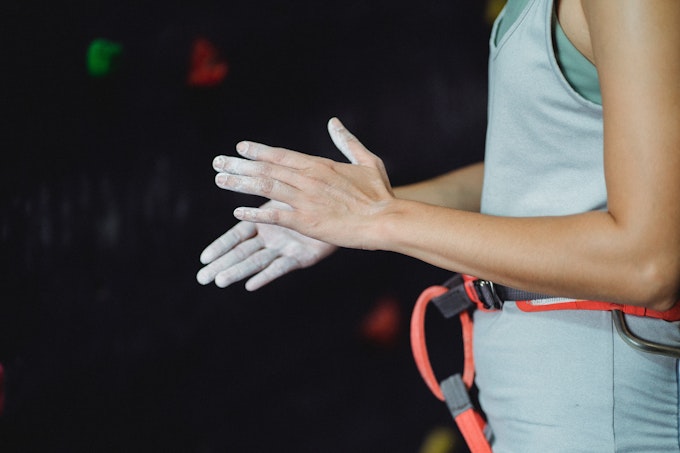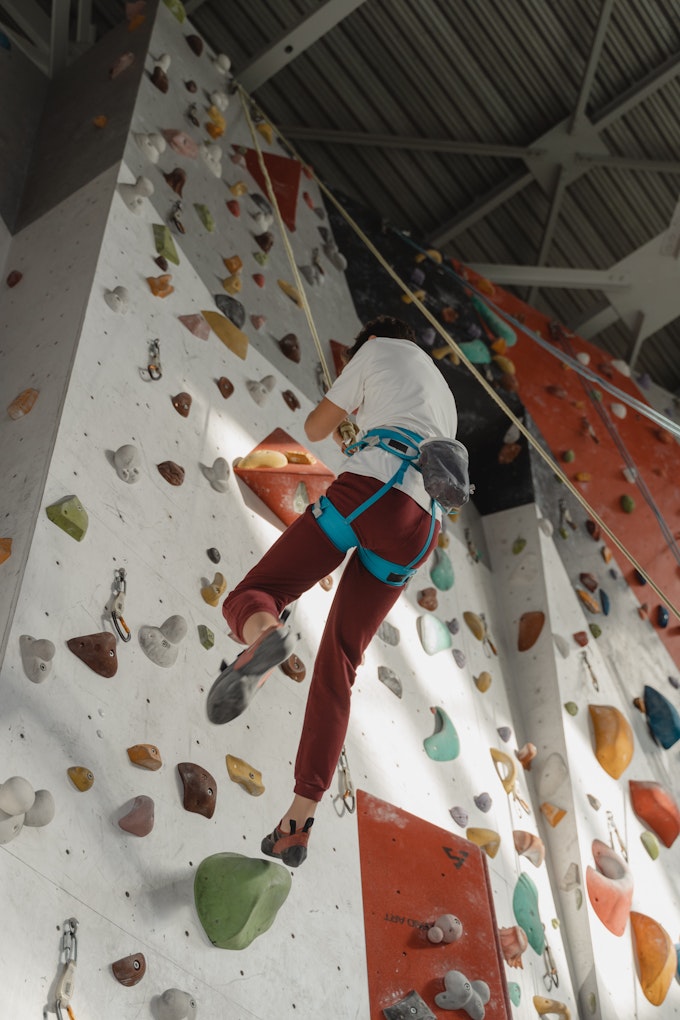New lingo for the beginner climber

Don’t let being a beginner or “not knowing anything” about a certain skill stop you from getting out there.
Starting something new can be intimidating, but building up your knowledge and vocabulary bit by bit will help build your confidence! I started climbing for the first time a little over a month ago and went in with little to no knowledge of the sport.
Here are some terms I’ve learned along the way that will be helpful for you to know if you’re someone who has an interest in giving climbing a go! And don’t stress– you don’t need to know or understand all these terms immediately. Speaking from personal experience, I think the best way to learn and get more comfortable is to put yourself out there and simply go for it! You’ll pick things up naturally as you go.
Belay
My definition: A rope system attached to an anchor at the top of a climbing wall used in two-person climbing. One end of the rope is attached to the climber and the other is attached to the belayer (person on the ground). As the climber ascends, the other person stays on the ground and tightens the slack of the rope to keep the climber secure should they fall.
Google definition: A variety of techniques climbers use to create friction within a climbing system, particularly on a climbing rope, so that a falling climber does not fall very far. (Wikipedia)
Belayer
My definition: In two-person climbing, the belayer is the person on the ground or following the lead climber who ensures that the climber has the right amount of loose or tightened rope. The belayer can tighten loose rope slack, “catch” a climber should they slip and fall off the wall (facilitated by the brake system attached to the belayer), and lower a climber when they are ready to descend. And if you find the right partner… the belayer can also shout encouragement or help you spot moves while you’re on the wall!
Google definition: A person who controls the safety rope for a climber; a person who turns a rope around a cleat, or belaying pin, to make it hold tight. (thefreedictionary.com)

Bouldering
My definition: A form of climbing that doesn’t require the use of any ropes. It’s done on a smaller wall (in an indoor gym) and is a great way to build strength, get comfortable with the feel of falling, and practice moves/certain grips. Bouldering can help you practice good technique for the bigger walls! It often leaves me feeling sore as it requires pure unassisted strength.
Google definition: A form of free climbing that is performed on small rock formations or artificial rock walls without the use of ropes or harnesses. (Wikipedia)
Anchor
My definition: When I think of the word anchor, I think of something strong that keeps an object in place– like the anchor of a boat. A climbing anchor essentially does this by acting as an attachment point for equipment like rope or a climber.
Google definition: An anchor can be any device or method for attaching a climber, a rope, or a load above or onto a climbing surface– typically rock, ice, steep dirt, or a building– either permanently or temporarily. (Wikipedia)
Carabiner
My definition: A sturdy, metal clip that looks like a loop and is commonly used in climbing to attach rope or other gear/equipment to.
Google definition: A specialized type of shackle, a metal loop with a spring-loaded gate used to quickly and reversibly connect components, most notably in safety-critical systems. (Wikipedia)
Auto-lock
My definition: Some carabiners will lock automatically after you clip in so you don’t have to tighten or lock the carabiner yourself. However, you should always double check that the carabiner is for sure locked even if it is an auto-locking one. If you’re uncertain, have your partner check too. It’s always good to double check all your gear/equipment and even your partner’s too.
Google definition: Spring-loaded, twisting mechanism on a carabiner gate that locks by itself when the gate is closed. (rei.com)

Chalk
My definition: Climbing chalk isn’t quite like the chalk your teachers growing up used to write equations on the chalkboard. This kind of chalk is more like chalk you see gymnasts use on their hands. It’s a white, crumbly, yet surprisingly soft powder that you can rub on the tips of your fingers to help with your grip. Your hands will likely get sweaty while you climb, so using chalk can be super helpful for keeping them dry and able to grab onto holds without slipping!
Google definition: Carbonate of magnesium, or gymnasts’ chalk, used to keep a climber’s hands dry for better grip (rei.com)
Double Figure 8
My definition: A knot that climbers use to tie into their harness– attaching themselves to the rope that they will use to ascend the wall in partner climbing. Like the name suggests, the knot itself looks like a figure 8– but with two parallel ropes.
Google definition: A type of knot that forms two parallel loops, and resembles the figure-eight loop. It is frequently used in climbing and caving as an easily untie-able knot that is capable of being attached to two bolts and equalized. (Wikipedia)
Fisherman’s Knot
My definition: An additional knot that climbers use to securely tie into their harness. It is tied after the double figure 8 knot. One side of the knot reveals two parallel lines while the other side shows an ‘X’. Always check that this is the case before starting to climb.
Google definition: Knot used for attaching two ends of accessory cord or rope together. Can be double or triple (have 2 or 3 wraps), depending on the type of material used. (rei.com)
Grigri
My definition: An interesting name for a metal piece of equipment that can fit in the palm of your hand. It is attached to a carabiner, which is then attached to the belayer’s harness. Rope feeds into this device, allowing the belayer to tighten or loosen rope slack for the climber. The grigri is also what is used for braking and lowering a climber back to the ground. A lever on the grigri can be lifted by the belayer, allowing rope to feed through an opening. The speed at which the climber descends is controlled by how much the belayer lifts the lever up. The descent shouldn’t be too fast– go slow and steady!
Google definition: An assisted braking belay device manufactured by Petzl designed to help secure rock-climbing, rappelling, and rope-acrobatic activities. Its main characteristic is a clutch that assists in braking under a shock load. (Wikipedia)
PBUS
My definition: This is an acronym for “Pull-Brake-Under-Slide.” This is the sequence of moves to perform when belaying a climber to tighten the slack of the rope. If a climber lets go of the wall, the less slack there is, the less far they will fall.
Google definition: Pull, Brake, Under, Slide technique. When you’re belaying a top-rope climber, most of your time is spent taking in slack as the person climbs. (rei.com)
Slack
My definition: When climbers talk about “slack,” it refers to the amount of excess rope given to the climber to move around. Tightening too much slack is important because it prevents the climber from falling great distances should they need to let go of the wall. Not giving a climber enough slack, on the other hand, may make it harder for them to move around. Be sure to know how to communicate clearly with your partner to convey your needs/take direction.
Google definition: When the rope is not tight against the climber or the anchor. Keeping a rope tight can pull a person leading off a wall, and while top roping, slack will lead to a larger fall than expected, so it can be both a tool and a hindrance to the climber. (rookieroad.com)

Rappel
My definition: The act of lowering down from an indoor rock wall or natural rock face by removing your hands from the wall and using your feet to carefully push off the surface while descending.
Google definition: To descend a cliff or other height by lowering oneself on a fixed rope, with feet against the wall. Friction is placed on the rope, usually with a belay device, to keep the descent slow and controlled. (rei.com)
Top-Rope
My definition: A type of two-person partner climbing. While one person climbs, the other acts as the belayer, watching the climber and managing the amount of slack and lowering the climber down when they are ready.
Google definition: A style in climbing in which the climber is securely attached to a rope which then passes up, through an anchor system at the top of the climb, and down to a belayer at the foot of the climb. (Wikipedia)
Boulder Problem
My definition: Climbing is not just a sport of sheer strength and flexibility. It also requires thinking and planning to a certain degree, which is part of the reason I enjoy it so much! It really forces you to be present while thinking through your next move. Different climbing routes at the gym will usually be marked using a grading system to give people an idea of its difficulty. In bouldering specifically, these different routes/paths are called “problems” as they can be puzzle-like in the sense that they require some thought and the planning of moves beforehand to make it to the top. You may have the strength and endurance to complete a climb, but the added element of “solving” how to do it makes it that much more fun!
Google definition: A sequence of moves (in bouldering) that lead to a defined top. It is climbed without a rope or any other kind of safety gear. (topobuldering.com)
Hopefully browsing this list helped give you a better idea of the lingo commonly tossed around in the world of climbing! Remember, you don’t need to know everything all at once. There’s no need to expect yourself to start using these terms in casual conversation like a pro. Take it one step at a time and seize every opportunity to talk to others more experienced than you. See for yourself how good it feels to try something new and have fun while doing it!
Cover photo: Cade Prior
We want to acknowledge and thank the past, present, and future generations of all Native Nations and Indigenous Peoples whose ancestral lands we travel, explore, and play on. Always practice Leave No Trace ethics on your adventures and follow local regulations. Please explore responsibly!
Do you love the outdoors?
Yep, us too. That's why we send you the best local adventures, stories, and expert advice, right to your inbox.








